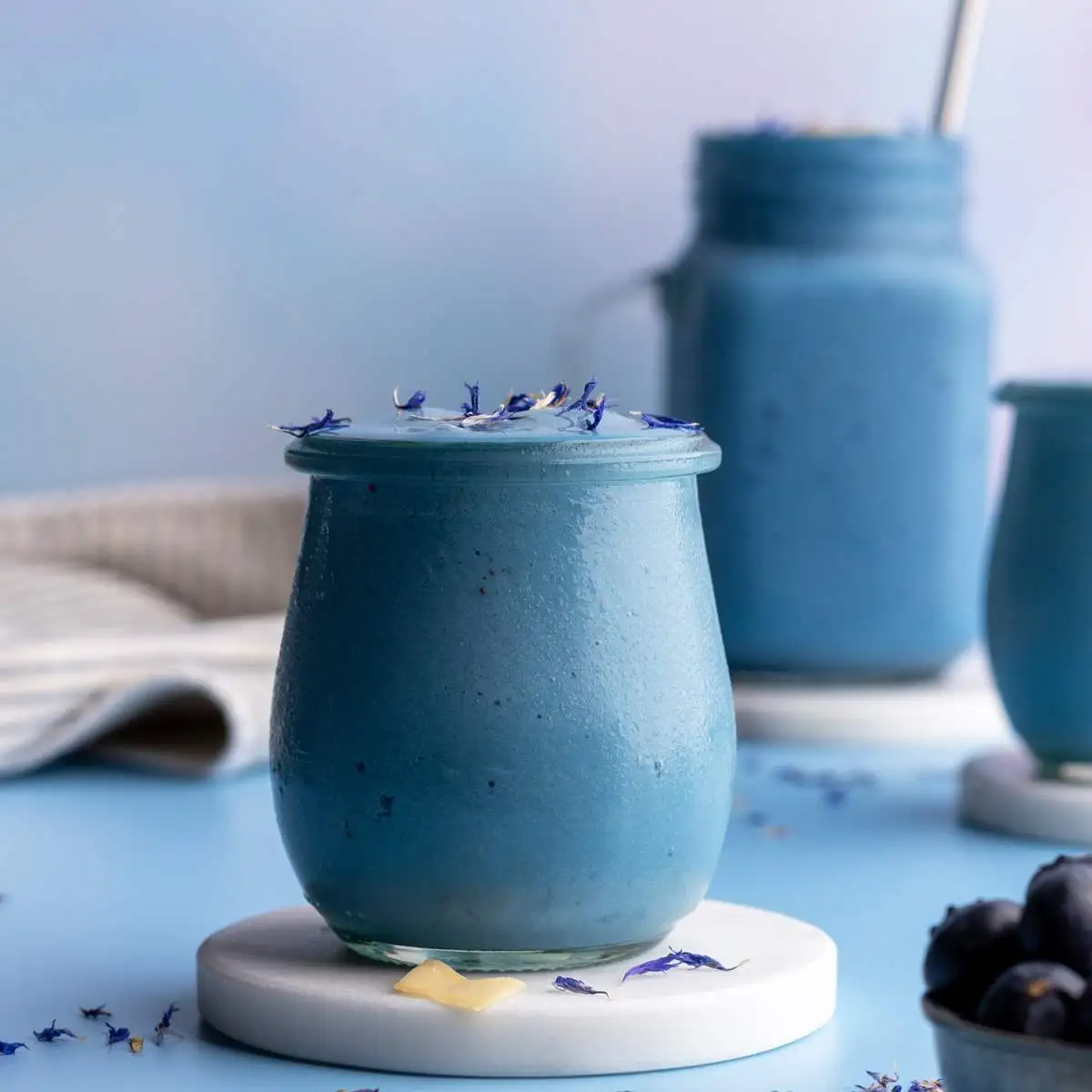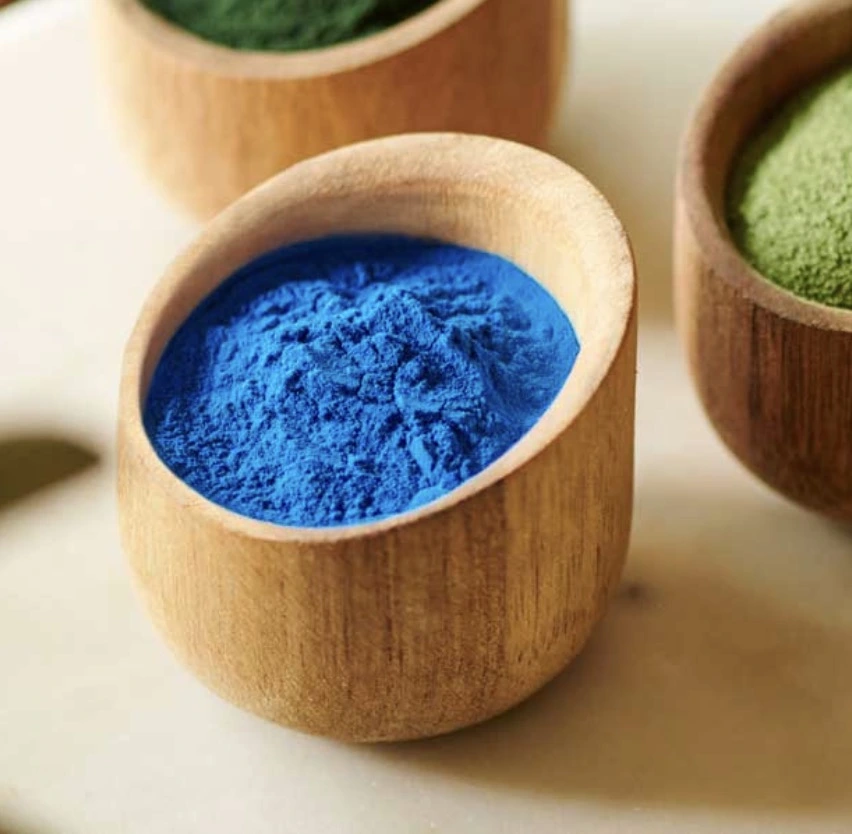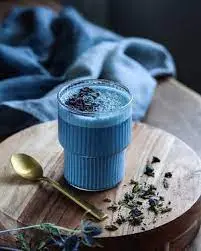Ceremonial Grade Matcha vs Culinary Grade Matcha
Matcha, the vibrant green powdered tea, has taken the world by storm with its unique flavor profile and numerous health benefits. As a matcha powder manufacturer, we understand the importance of distinguishing between different grades of matcha. In this comprehensive guide, we'll delve into the key differences between ceremonial grade matcha and culinary grade matcha, helping you make informed decisions about which type to use for your tea or culinary creations.
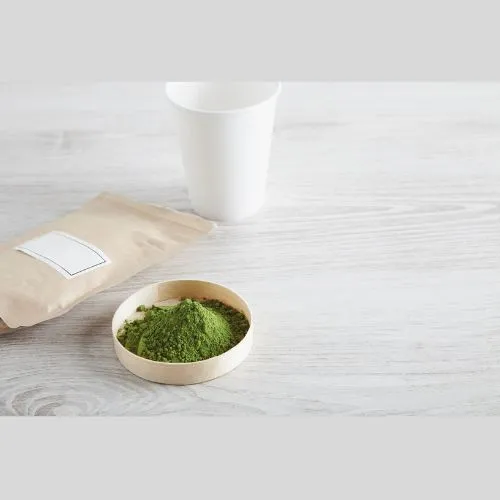
Key Differences Between Ceremonial and Culinary Matcha
Harvesting and Processing
The journey of matcha begins in the tea fields, where careful cultivation practices set the stage for the final product's quality. Ceremonial grade matcha and culinary grade matcha differ significantly in their harvesting and processing methods.
Ceremonial grade matcha is crafted from the youngest, most tender leaves of the Camellia sinensis plant. These prized leaves are typically harvested during the first flush of spring, when the plants are at their peak nutritional content. The leaves are meticulously hand-picked to ensure only the finest quality makes it into the final product.
In contrast, culinary grade matcha is often made from leaves harvested later in the season. While still of good quality, these leaves may be slightly more mature and less tender than those used for ceremonial grade. The harvesting process for culinary grade matcha may also involve mechanical methods, allowing for larger-scale production.
Shade-Growing Techniques
Both ceremonial and culinary grade matcha undergo a shade-growing process, but the duration and intensity of shading can vary. This crucial step in matcha production influences the tea's flavor, color, and nutritional profile.
For ceremonial grade matcha, tea plants are typically shaded for up to 20-30 days before harvesting. This extended period of reduced sunlight exposure prompts the plants to produce more chlorophyll and amino acids, resulting in a vibrant green color and a sweeter, more umami-rich flavor profile.
Culinary grade matcha may undergo a shorter shading period, often around 10-20 days. While still beneficial, this reduced shading time may result in a slightly less intense color and a more robust, slightly bitter flavor that can stand up to other ingredients in culinary applications.
Grinding Process
The grinding process is a critical step in matcha production, significantly impacting the powder's texture and overall quality. Both ceremonial and culinary grade matcha powder are ground into fine powders, but there are notable differences in the grinding techniques used.
Ceremonial grade matcha is ground using traditional stone mills, a process that can take up to an hour to produce just 30 grams of powder. This slow, meticulous grinding helps preserve the tea's delicate flavors and ensures an ultra-fine texture that dissolves smoothly in water.
Culinary grade matcha may be ground using more modern, efficient methods that allow for larger-scale production. While still resulting in a fine powder, the texture may be slightly coarser than ceremonial grade. This difference in texture makes culinary grade matcha ideal for use in recipes where it needs to blend well with other ingredients.
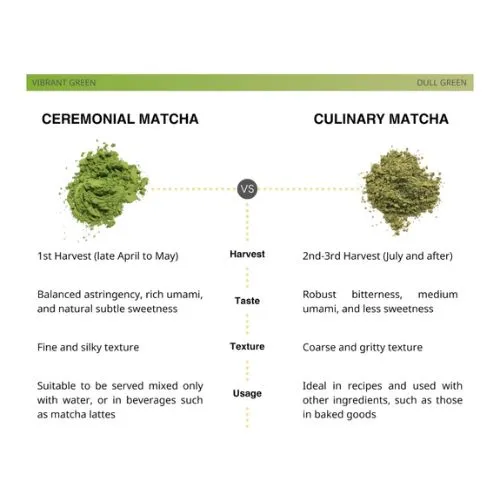
Which Matcha Powder Is Best for Tea or Recipes?
Choosing the Right Matcha for Tea
When it comes to enjoying matcha as a traditional tea, ceremonial grade matcha is the undisputed champion. Its superior quality and delicate flavor profile make it the ideal choice for those seeking an authentic matcha experience.
Ceremonial grade matcha boasts a smooth, subtle sweetness with notes of umami and a pleasant, lingering aftertaste. When whisked with hot water, it produces a creamy, frothy texture that is both visually appealing and satisfying to drink. The vibrant green color of ceremonial grade matcha is also a testament to its high quality and careful processing.
For matcha connoisseurs and those practicing the Japanese tea ceremony, ceremonial grade matcha is essential. Its refined taste and aroma allow for a pure, unadulterated matcha experience that showcases the tea's true essence.
Selecting Matcha for Culinary Applications
While ceremonial grade matcha is the go-to choice for traditional tea preparation, culinary grade matcha shines in a wide range of recipes and food applications. Its more robust flavor profile and slightly coarser texture make it well-suited for use in baking, cooking, and beverage creation.
Culinary grade matcha can withstand the addition of other ingredients without losing its distinct matcha flavor. This makes it ideal for incorporating into recipes such as matcha lattes, smoothies, ice cream, baked goods, and even savory dishes. The slightly stronger taste of culinary grade matcha can hold its own against milk, sweeteners, and other flavors, ensuring that the matcha flavor remains prominent in the final product.
Additionally, the more affordable price point of culinary grade matcha makes it a practical choice for recipes that require larger quantities of matcha powder. This allows chefs and home cooks to experiment with matcha-infused creations without breaking the bank.
Versatility in Matcha Usage
While there are clear distinctions between ceremonial and culinary grade matcha, it's important to note that these categories are not entirely rigid. Some high-quality culinary grade matcha can be enjoyable when prepared as traditional tea, especially for those who prefer a stronger flavor profile.
Conversely, ceremonial grade matcha can be used in culinary applications for those seeking the utmost quality in their matcha-infused creations. However, the subtle nuances of ceremonial grade matcha may be overshadowed when combined with other ingredients, making it a less cost-effective choice for most culinary uses.
Ultimately, the choice between ceremonial and culinary grade matcha depends on personal preference, intended use, and budget considerations. Many matcha enthusiasts keep both grades on hand to enjoy the best of both worlds – pure, traditional matcha tea and creative culinary explorations.
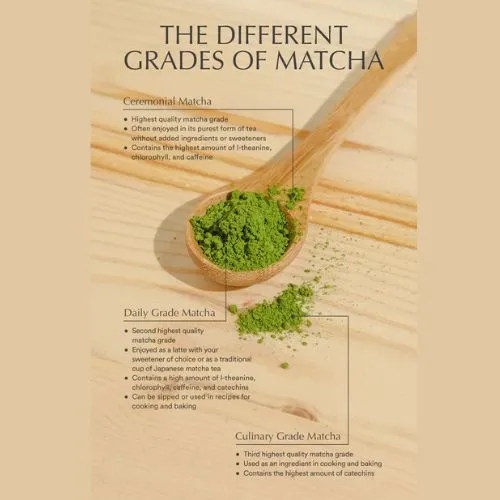
Taste, Quality, and Uses of Matcha Powder Grades
Flavor Profiles and Tasting Notes
The taste of matcha is a complex interplay of flavors that can vary significantly between ceremonial and culinary grades. Understanding these flavor profiles can help you choose the right matcha for your needs and appreciate the nuances of this remarkable tea.
Ceremonial grade matcha is prized for its smooth, delicate flavor profile. When prepared properly, it offers a harmonious balance of sweetness and umami, with subtle vegetal notes reminiscent of fresh grass or seaweed. The taste is often described as creamy and full-bodied, with a lingering sweetness that coats the palate. High-quality ceremonial grade matcha should have little to no bitterness or astringency, allowing the tea's natural sweetness to shine through.
Culinary grade matcha, on the other hand, tends to have a more robust and slightly bitter flavor profile. This stronger taste is actually advantageous in culinary applications, as it allows the matcha flavor to stand out when combined with other ingredients. Culinary grade matcha may have more pronounced grassy or earthy notes, with a touch of astringency that can add depth to recipes. While it may be less smooth when consumed on its own, culinary grade matcha's bold flavor makes it an excellent choice for matcha-flavored desserts, smoothies, and other creative culinary uses.
Quality Indicators and Grading Systems
While the terms "ceremonial" and "culinary" provide a general guide to matcha quality, it's important to note that there is no standardized grading system for matcha. However, there are several key indicators that can help assess the quality of matcha powder:
1. Color: High-quality matcha should have a vibrant, bright green color. Ceremonial grade matcha typically boasts a more intense green hue compared to culinary grade. Dull or yellowish-green colors may indicate lower quality or improper storage.
2. Texture: The finest matcha powders have an incredibly fine, smooth texture that feels almost silky to the touch. Ceremonial grade matcha should be ground to an exceptionally fine consistency, while culinary grade may be slightly coarser but still very fine.
3. Aroma: Fresh, high-quality matcha should have a pleasant, sweet aroma with grassy or vegetal notes. The scent should be inviting and not overly strong or musty.
4. Origin: The region where matcha is produced can influence its quality. Matcha from renowned tea-growing areas in Japan, such as Uji in Kyoto Prefecture, is often associated with superior quality.
5. Processing: Stone-ground matcha is typically considered higher quality than matcha ground by other methods. The slow, traditional grinding process helps preserve the tea's delicate flavors and nutrients.
Innovative Uses for Different Matcha Grades
As a matcha powder manufacturer, we've observed the growing versatility of matcha in both traditional and modern applications. While ceremonial grade matcha is primarily used for traditional tea preparation, and culinary grade for cooking and baking, innovative uses for both grades continue to emerge.
Ceremonial grade matcha is finding its way into high-end cocktails, where its delicate flavor can add a sophisticated touch to mixology creations. Some skincare brands are also incorporating ceremonial grade matcha into face masks and serums, capitalizing on its antioxidant properties and vibrant color.
Culinary grade matcha has seen an explosion of creative uses beyond traditional baking and cooking. It's being used in savory dishes like matcha-crusted fish or matcha salt for seasoning. In the beverage industry, culinary grade matcha is a popular addition to protein shakes, energy drinks, and even beer. Some innovative chefs are even using culinary grade matcha as a natural food coloring agent in pasta, breads, and other dishes.
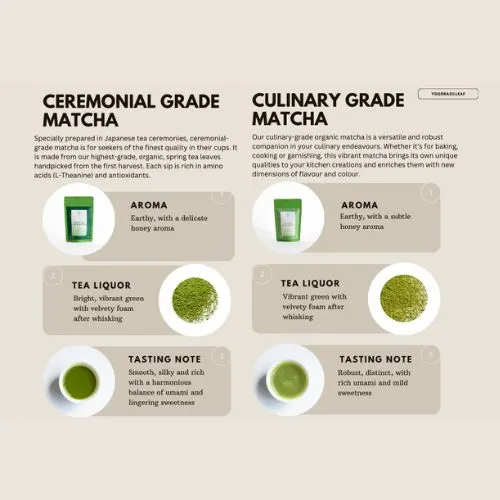
Conclusion
Understanding the differences between ceremonial and culinary grade matcha is crucial for both consumers and food industry professionals. Ceremonial grade matcha offers a pure, refined tea experience ideal for traditional preparation, while culinary grade matcha provides versatility and robust flavor for a wide range of culinary applications. By choosing the appropriate grade for your needs, you can fully appreciate the unique qualities of this remarkable green tea powder. As a leading matcha powder manufacturer, we at Yangge Biotech are committed to providing high-quality matcha powders for all your needs, whether you're seeking the perfect cup of tea or innovative ingredients for your culinary creations. At Yangge Biotech, we specialize in producing high-quality matcha powder for various applications in the food and beverage industry. Our matcha powder is available in both ceremonial and culinary grades, ensuring we can meet all your business needs. With our ISO, HACCP, Kosher, and Halal certifications, you can trust in the quality and safety of our products. Whether you're looking to create premium matcha teas, innovative culinary creations, or health-focused supplements, our team is here to support you. Contact us at info@yanggebiotech.com to discover how our matcha powder can elevate your products and delight your customers.
FAQ
Q: Can we get some samples to test before purchasing?
A: Of course, we can provide free samples of 20 to 100 grams, but the shipping cost is at the customer's expense. The shipping cost can be deducted from the next order, or the samples can be sent through your courier account.
Q: Do your products have relevant certifications?
A: Yes, our products are certified for HALAL, ISO, HACCP, Kosher, and other certifications.
Q: What is the minimum order quantity (MOQ)?
A: Small batches of samples can be customized according to your requirements.
Q: Do you offer OEM and ODM services? Can the formula be customized based on our own?
A: Of course, we provide ODM and OEM services to many customers. Our product range includes softgels, capsules, tablets, sachets, granules, and private label services. Simply contact us and let us know your requirements. Our experienced R&D team can also develop new products with specific formulas.
Please contact us to design your own branded products.
Q: How do you handle quality complaints?
A: First, we have a comprehensive quality control SOP. We provide authoritative third-party inspection reports for almost all products before shipment to minimize the possibility of quality issues. Second, we have a comprehensive return and exchange procedure. If there is a genuine quality dispute, we will strictly follow the SOP.
Q: How do you ship? How long does delivery take?
A: For small orders, we typically use DHL, UPS, EMS, FedEx, or TNT. Delivery typically takes 3-7 days. We also offer air and sea freight services. We have a strong freight forwarding team and can provide you with a one-stop service, including DDP and DDU.
Q: What are your payment terms?
A: 100% prepayment, payable by T/T, Western Union, MoneyGram, or PayPal.
Q: What is the shelf life of your products?
A: 2 years with proper storage.
Q: Is the packaging environmentally friendly?
A: We attach great importance to environmental protection and are constantly improving our product packaging. Some products are packaged in recyclable paper. Packaging materials are carefully selected to ensure product safety during transportation and storage, and to minimize environmental impact. We are committed to achieving a balance between environmental friendliness and practicality in our product packaging, and to contributing to sustainable development.
Referrence
1. Koláčková, T., et al. (2020). "Matcha Tea: Analysis of Nutritional Composition, Phenolics and Antioxidant Activity." Plant Foods for Human Nutrition, 75(1), 48-53.
2. Fujioka, K., et al. (2016). "The Powdered Green Tea Study: The Influence of Particle Size and Manufacturing Process on Properties of Powdered Green Tea." Journal of Food Science and Technology, 53(7), 2957-2965.
3. Kochman, J., et al. (2021). "Health Benefits and Chemical Composition of Matcha Green Tea: A Review." Molecules, 26(1), 85.
4. Unno, K., et al. (2018). "Stress-Reducing Function of Matcha Green Tea in Animal Experiments and Clinical Trials." Nutrients, 10(10), 1468.
5. Xu, P., et al. (2016). "The Effects of Different Processing Methods on the Antioxidant Activity of Matcha and Analysis of Its Constituents." Food Science and Technology Research, 22(5), 661-667.

Based on your location and order quantity, you will have the opportunity to receive a limited time free shipping promotion!
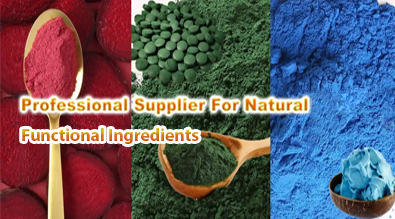
Who we are
